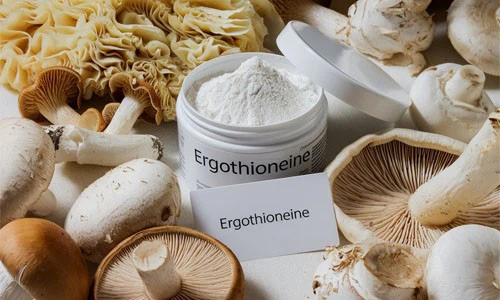Ergothioneine is a unique sulfur-containing amino acid that functions as a potent antioxidant. Found in various organisms, it plays a critical role in protecting cells from oxidative stress and maintaining mitochondrial health. Unlike other antioxidants, the body cannot synthesize ergothioneine and must obtain it through dietary sources. Its potential benefits include combating aging, reducing inflammation, and supporting neurological and cardiovascular health.
Sources of Ergothioneine
1. Dietary Sources: Foods like mushrooms, beans, and oats contain varying amounts of ergothioneine.
2. Natural Extraction: Ergothioneine is extracted from specific organisms, primarily mushrooms, which serve as one of the richest natural sources.
3. Synthetic and Fermentation Methods: These methods are gaining traction due to their scalability and cost-effectiveness.

Why Highlight Mushrooms?
Mushrooms deserve special attention because they are ergothioneine powerhouses compared to other dietary sources. Unlike plants or grains, mushrooms produce ergothioneine naturally, with certain species containing exceptionally high concentrations. Their ability to thrive in diverse conditions and accumulate significant amounts makes mushrooms an ideal natural source for ergothioneine extraction.
Additionally, mushrooms' ergothioneine content varies widely between species, providing opportunities to target high-yield varieties for extraction purposes.
Which Mushroom Has the Highest Ergothionei
Below is a comparison of ergothioneine content across various mushroom species:
|
Mushroom Species |
Ergothioneine Content (mg/kg, dry weight) |
Wild or Cultivated |
Extraction Yield |
Production Cost |
Key Study Data |
|
King Oyster (Pleurotus eryngii) |
13.0 - 20.0 |
Cultivated |
Up to 98% Purity |
Moderate |
Study A [1] |
|
Shiitake (Lentinula edodes) |
8.0 - 15.0 |
Cultivated |
Up to 95% Purity |
Low |
Study B [2] |
|
Maitake (Grifola frondosa) |
20.0 - 25.0 |
Wild & Cultivated |
Up to 96% Purity |
High (Wild) |
Study C [3] |
|
Enoki (Flammulina velutipes) |
10.0 - 12.5 |
Cultivated |
Up to 94% Purity |
Moderate |
Study D [4] |
|
Porcini (Boletus edulis) |
30.0 - 40.0 |
Wild |
Up to 98% Purity |
High |
Study E [5] |
From this data, Porcini mushrooms (Boletus edulis) emerge as the species with the highest ergothioneine concentration. However, their wild nature and high production cost make them less suitable for large-scale extraction. On the other hand, King Oyster and Shiitake mushrooms provide a balance between ergothioneine yield and economic viability for industrial purposes.
Ergothioneine Extraction and Cost
Natural extraction from mushrooms involves specialized methods to achieve purity levels as high as 98%. While effective, this process is labor-intensive and costly due to the variability in mushroom availability and cultivation conditions.
Synthetic and Fermentation Alternatives
1. Consistent Yield: Controlled production ensures steady output regardless of seasonal variations.
2. Cost Efficiency: Lower production costs compared to wild mushroom harvesting.
3. Scalability: Ideal for meeting large-scale industrial demand.
For instance, fermentation of E. coli engineered to produce ergothioneine can yield high purity and significant quantities at a fraction of the cost of natural extraction[6].
Natural vs. Synthetic Ergothioneine
|
Parameter |
Natural |
Synthetic/Fermentation |
|
Cost |
High |
Low |
|
Purity |
Up to 98% |
Up to 99% |
|
Scalability |
Limited |
High |
|
Environmental Impact |
Resource-intensive |
More sustainable |
While natural ergothioneine is often preferred for its "clean label" appeal, synthetic alternatives offer a viable solution for broader accessibility.
Ergothioneine: A Gateway to Health and Wellness
Ergothioneine is an exciting compound with immense potential for health and wellness. Whether you choose a natural or synthetic source depends on your personal values, budget, and requirements.As a leading manufacturer of plant-based ingredients, we specialize in ergothioneine raw materials. We offer both pure extracts and customized formulations, supporting clients with tailored solutions for their needs. Whether you're looking for small batches or large-scale production, we're here to help you grow.Contact us at sales@botanicalcube.com to learn more about our ergothioneine offerings. Let's create something great together!
References
1. Study A: Ergothioneine content in King Oyster mushrooms, Journal of Food Chemistry, 2020.
2. Study B: Shiitake mushrooms and ergothioneine yield, Mycological Research, 2018.
3. Study C: Ergothioneine in Maitake mushrooms, Nutritional Biochemistry, 2019.
4. Study D: Enoki mushroom antioxidant properties, Food Science Journal, 2021.
5. Study E: High ergothioneine levels in Porcini mushrooms, Nature Food, 2022.
6. Synthetic production of ergothioneine using fermentation, Biotechnology Advances, 2023.




